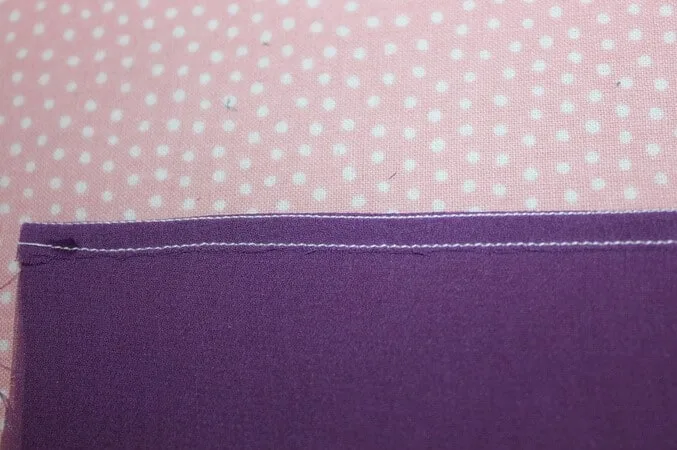In this sewing tutorial, I will show you how to sew a flat felled seam.
The term “flat-felled seams” sounds to me a little bit too professional but the technique itself is not too complicated and can be widely used in home sewing.

Flat felled seams can be usually found in denim because they are very strong and durable. You can use a flat felled seam when sewing bedding, sportswear, and equipment, men’s shirts, special work clothes, jeans, skirts, trousers, clothes that need to be washed very often, etc.
But flat-felled seams can be decorative also. And they can be used on lightweight silk fabric.
A distinctive feature of the flat felled seam is that two lines are visible on one side of the seam, and only one line on the other.
I like to use them even on chiffon and organza (together with French seams). Maybe I am the only one but anyway, to me flat-felled seams look awesome.
I used them recently while sewing my silk fitted sheet. So I can assure you that they are really as suitable for delicate silk fabric as they are suitable for denim. If you would like to read that tutorial on how to sew a fitted sheet (from 100% silk fabric) here is the link.

Please note that some measurements in this article are provided in millimeters and centimeters so if you are used to working with the imperial system please use this chat from my guide “All about a tape measure for sewing”
If you would like to have the chart as a printable you can go to my RESOURCE LIBRARY (free for my subscribers) and download the chart as a PDF (and print it).
Note: Some of the links on this page are affiliate links. This means I will receive a commission if you order a product through one of my links. I only recommend products I believe in and use myself.
I think I am doing flat-felled seams a little bit differently than I found in available tutorials. The result is the same though: seam allowances are fully enclosed, they are really flat and on one side of the item you can see two stitch lines, and on the other side only one stitch line.
So what are the steps to sew flat-felled seams on silk (and other lightweight fabric as well)? I will demonstrate the steps using 2 different fabrics: silk chiffon and silk charmeuse.
Step 1
Pin the fabric right sides together (wrong sides out).
I need to mention though that for silk fabric you need to use very sharp extra fine glass heads and long pins (so they don’t leave any holes in the material). The link above is what I bought and use, in addition to Dritz. This is one of the few simple items where I really recommend you buy the brand name unless you already have reasons to trust a no-name brand.

Or you can use Wonder clips instead of pins. Here is an affiliate link for Etsy for comparison: Wonder Clips.

If you prefer Amazon, below are links to Amazon products that I bought myself.
Stitch keeping correct seam allowances for your project. For example, if your seam allowances are ⅝ inch then stitch 5/16“ from the edges – divide the seam allowances in half.
For this tutorial, I used scrap pieces of silk fabric – just to show you how to sew a flat felled seam. I didn’t have any particular project in mind. So I stitched 5/8 inch (or about 1.5 cm) from the edges with the stitch length of 2.2 mm for silk fabric. By the way, I have a tutorial on setting the stitch length for different fabrics and for different stitches. Check it out if you are interested.


And also I always use 100% silk threads (this is an Etsy link) to work with silk fabric. They are smooth, quite strong, yet delicate, have a lustrous sheen, and glide through the silk fabric with amazing ease. Remember that your thread shouldn’t be heavier than the fabric.
Silk threads are just amazing! They are very thin but they are also very strong.
Step 2
Press seams first and after that fold the seams exactly along the stitch line and press again.


Step 3
Increase stitch length to 2.7 mm and stitch over folded seams 3/16 inch (or 5 mm) from the first stitch line ( or from the folded edge, which is the same in this case).

Step 4
Trim excess fabric carefully (so you don’t cut stitches) close to the second stitch line using small scissors.


I recommend the Duck Bill Scissors (Etsy link). I can’t live without these magical scissors anymore. They have a wide outer edge that lifts fabric (that was cut) away without harming the threads. The handles are curved and because of this, your hand won’t be in the way while you trim the fabric. And these scissors are really sharp.
I like them so much that I have actually written an article about the item: Duckbill Scissors: What They Are And How To Use Them. Give it a try, you may even find some interesting info!

Below is a link for Amazon. I have myself bought and I am very satisfied with the Gingher brand which, even if more expensive, does a very good job for me. I have also other brands which work well.
Step 5
Fold the fabric along the trimmed line – this way you will hide the raw edge inside the seam. Thoroughly press this turned-under seam on one side flat.


Step 6
This is the final step – carefully stitch the seam along the folded edge keeping an even distance from the other stitch line and not going off the folded edge. Try to sew as straight as possible for a professional-looking finish. I have a very popular tutorial on How to sew straight, check it out.
Here it is, the flat felled seam. Durable, reliable, and beautiful.
I think this method makes a great finish if you can sew it accurately and is faster and easier than the one I found online. I am pretty happy with the result.



If you prefer you can watch the tutorial on my YouTube channel below (about 9 min 30 sec):
Did you find this tutorial helpful? If so, save this pin (see below) on your sewing board so you can come to this tutorial later when you are ready to sew a flat-felled seam, and follow me on Pinterest for more tips, tutorials, and inspiration!


How to sew sheer fabric using only the bobbin thread for stitching

Narrow hem tutorial: how to make a narrow hem using a Ban Roll tape

How To Choose Flattering Clothes For A Big Stomach

How To Cut Fabric Straight | 8 Easy Ways Explained
latest posts
- Knot a Problem: Easy Ways to Secure Short Thread Ends
- Ever Tried This on Your Serger? This Differential Feed Feature Will Amaze You
- Ditch My Sewing Machine? Not in This Lifetime!
- Adorable DIY Needle Book | Easy Tutorial for Beginners
- Master the Seam Ripper: Your Ultimate Guide to Precision Stitch Removal
- Think You Know Zippers? This Installation Guide Might Surprise You
- Why Does Your Seam Ripper Have a Red Ball? Discover Its Purpose!
- Topstitching Troubles? This Simple Trick Will Turn It Around Instantly!
- How to Sew Shirring: A Step-by-Step Guide to Elastic Thread Gathering



